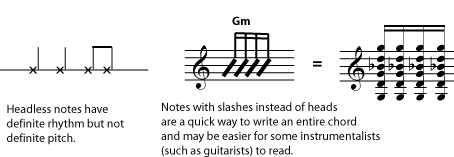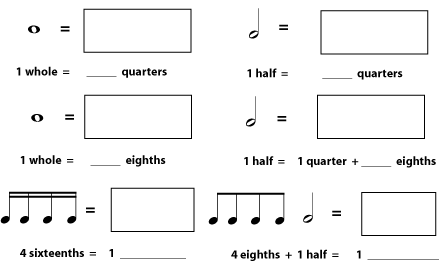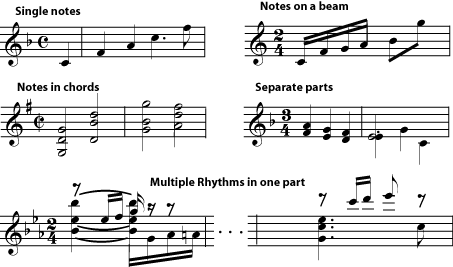| << Chapter < Page | Chapter >> Page > |
In standard notation, a single musical sound is written as a note . The two most important things a written piece of music needs to tell you about a note are its pitch - how high or low it is - and its duration - how long it lasts.
To find out the pitch of a written note, you look at the clef and the key signature , then see what line or space the note is on. The higher a note sits on the staff , the higher it sounds. To find out the duration of the written note, you look at the tempo and the time signature and then see what the note looks like.

The pitch of the note depends only on what line or space the head of the note is on. (Please see pitch , clef and key signature for more information.) If the note does not have a head (see [link] ), that means that it does not have one definite pitch.

The head of the note may be filled in (black), or not. The note may also have (or not) a stem, one or more flags, beams connecting it to other notes, or one or more dots following the head of the note. All of these things affect how much time the note is given in the music.

The simplest-looking note, with no stems or flags, is a whole note . All other note lengths are defined by how long they last compared to a whole note. A note that lasts half as long as a whole note is a half note . A note that lasts a quarter as long as a whole note is a quarter note . The pattern continues with eighth notes , sixteenth notes , thirty-second notes , sixty-fourth notes , and so on, each type of note being half the length of the previous type. (There are no such thing as third notes, sixth notes, tenth notes, etc.; see Dots, Ties, and Borrowed Divisions to find out how notes of unusual lengths are written.)

You may have noticed that some of the eighth notes in [link] don't have flags; instead they have a beam connecting them to another eighth note. If flagged notes are next to each other, their flags can be replaced by beams that connect the notes into easy-to-read groups. The beams may connect notes that are all in the same beat, or, in some vocal music, they may connect notes that are sung on the same text syllable. Each note will have the same number of beams as it would have flags.

You may have also noticed that the note lengths sound like fractions in arithmetic. In fact they work very much like fractions: two half notes will be equal to (last as long as) one whole note; four eighth notes will be the same length as one half note; and so on. (For classroom activities relating music to fractions, see Fractions, Multiples, Beats, and Measures .)
Draw the missing notes and fill in the blanks to make each side the same duration (length of time).


So how long does each of these notes actually last? That depends on a couple of things. A written note lasts for a certain amount of time measured in beats . To find out exactly how many beats it takes, you must know the time signature . And to find out how long a beat is, you need to know the tempo .

Whether a stem points up or down does not affect the note length at all. There are two basic ideas that lead to the rules for stem direction. One is that the music should be as easy as possible to read and understand. The other is that the notes should tend to be "in the staff" as much as reasonably possible.


Notification Switch
Would you like to follow the 'Reading music: common notation' conversation and receive update notifications?